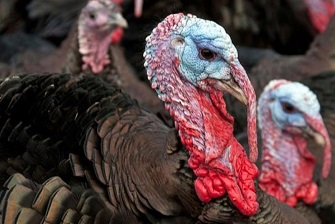H5N1 News: Various Turkey And Chicken Farms Across United States Facing New H5N1 Surge With Threat To Coming Thanksgiving Meals!
Nikhil Prasad Fact checked by:Thailand Medical News Team Oct 12, 2023 1 year, 6 months, 1 week, 1 day, 27 minutes ago
H5N1 News: The resurgence of the highly pathogenic H5N1 avian influenza, commonly known as bird flu, in various turkey and chicken farms across the United States has raised concerns about its impact on the poultry industry and the potential threat to Thanksgiving meals.

The outbreaks in Minnesota, South Dakota, and Utah have put commercial poultry flocks at risk, and experts fear that more cases may follow, given the onset of migration season.
https://www.aphis.usda.gov/aphis/ourfocus/animalhealth/animal-disease-information/avian/avian-influenza/hpai-2022/2022-hpai-commercial-backyard-flocks
Minnesota's Meeker County was the site of the latest outbreak, affecting a commercial turkey flock of 140,000 birds. South Dakota confirmed bird flu in a flock of approximately 47,000 turkeys in Jerauld County on October 4th, while a farm with 141,800 birds in Utah's Sanpete County also reported the disease last week.
These incidents mark the first appearances of highly pathogenic bird flu in commercial poultry flocks in the U.S. this season. The previous outbreak had affected two turkey farms in the Dakotas in April. To control the spread of the virus, infected flocks are typically destroyed, and the affected farms undergo thorough decontamination.
Before these recent developments, the only reports of bird flu in the U.S. had been limited to sporadic appearances in backyard flocks and among wild birds such as ducks, geese, and eagles. While wild birds often exhibit no symptoms of avian influenza, the infections among them pose a significant concern to the poultry industry as migrating birds can serve as carriers and spread the disease to vulnerable commercial flocks.
Beth Thompson, South Dakota State Veterinarian, expressed her belief to various
H5N1 News outlets that more cases could emerge as migration season commences.
The United States faced a severe bird flu outbreak last year, resulting in the loss of nearly 59 million birds across 47 states, including egg-laying chickens and turkeys, which marked the deadliest outbreak in the country's history. This outbreak led to spikes in egg and turkey prices for consumers and incurred a cost of over $660 million for the government.
The 2015 outbreak of bird flu, which was deemed the most expensive animal health disaster in U.S. history, led to the loss of nearly 51 million birds in 15 states. Bird flu infections in humans are relatively rare and are not considered a food safety risk. However, there is concern that the virus could evolve to spread more easily among people, especially as it affects other species, including some mammals.
In a recent development, Cambodia reported its third human death from bird flu this year, underscoring the potential risks associated with the virus.
https://www.thailandmedical.news/news/breaking-h5n
1-news-cambodian-man-dies-from-h5n1-avian-flu-infection-in-the-last-24-hours
American agriculture officials consider the cases this year to be an extension of the 2022 outbreak, which initially emerged in Europe and reached the United States in February 2022. In response, the U.S. imposed periodic restrictions on poultry imports from Europe to limit the potential for further spread. Thompson noted that the virus had never completely disappeared, unlike in 2015, and that the current strain is essentially the same as the one that spread last year.
Bailee Woolstenhulme, spokesperson for the Utah Department of Agriculture and Food, emphasized the importance of maintaining biosecurity practices to prevent avian flu. However, poultry producers have already been diligent about biosecurity for several years, leaving little room for additional measures beyond what they have already taken. The primary strategy is to prevent the transmission of the virus through the introduction of wild bird droppings into poultry barns, whether via workers' footwear and clothing or hitchhiking on farm equipment, small birds, mice, and even dust particles.
Despite these efforts, Utah reported its first case of bird flu this year, affecting a commercial turkey farm. In the previous year, 16 turkey farms, one egg farm, and several backyard flocks in the state were also affected by the virus.
Last year, South Dakota's poultry producers suffered substantial losses, with nearly 4 million birds succumbing to the disease. Iowa, the hardest-hit state, with nearly 16 million birds lost, has not recorded a new case since March, offering a glimmer of hope for the region.
The current resurgence of bird flu is a stark reminder of the ongoing challenges faced by the poultry industry in the United States and the need for constant vigilance to prevent and manage disease outbreaks. As the nation approaches the Thanksgiving holiday, there are growing concerns about the impact of these recent outbreaks on the availability and cost of turkey and chicken products, potentially affecting traditional Thanksgiving meals. The situation underscores the importance of biosecurity measures and the close monitoring of poultry farms as they strive to protect their flocks and the nation's food supply.
For the latest
H5N1 News, keep on logging to Thailand Medical News.
